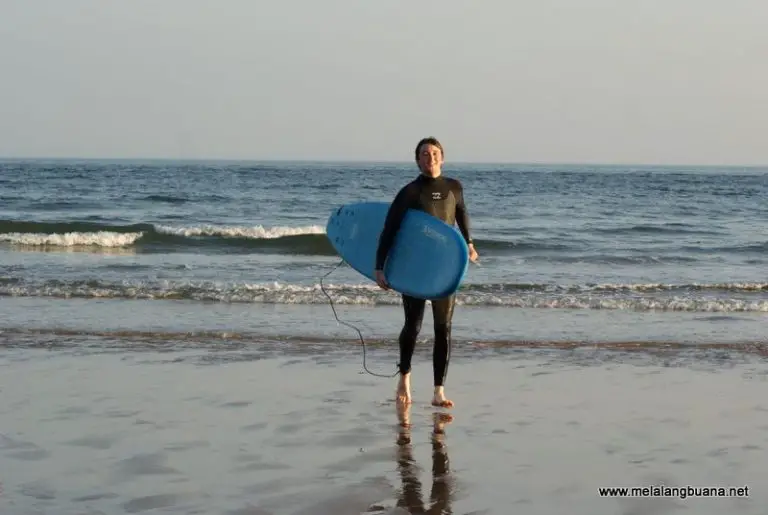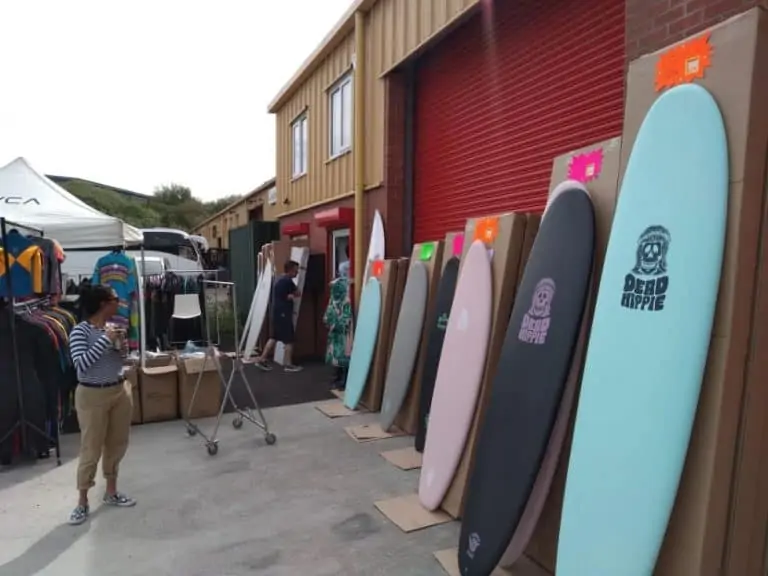How Long Should a Surfboard Last? (EVERY Type of Board!)
Buying a surfboard is an investment for anyone since they do not come cheap.
When buying the right board, you will obviously want to get a board that is the right size and shape for you at your level and that allows for progression.
However, surfboards can vary massively in price, so know that you are going to get enough bang for your buck is important.
As such, to help give you an idea of how long a surfboard should last, the table below displays the type of surfboards by construction and how many years use you can expect to get out of each:
| Type of Surfboard | Years it Should Last |
| Standard Fiberglass Polyurethane (PU) | 5-10 |
| Epoxy Construction | 15-20 |
| Hybrid Composite Construction | 10-20 (depending) |
| Foam Soft Top | 5-10 |
Now, this needs a little bit more explaining since there is quite a range, as you can no doubt see. So, to help give you a clearer idea, we’ll run through each type of surfboard and some of the points to consider below.
But, before doing that, it’s important to explain each factor that contributes to the wide range in the lifespan of a surfboard. So let’s take a look at that now.
Key Factors to Consider for Lifetime of a Surfboard
Frequency of Use
There is a huge difference in the amount of years you can expect out of a surfboard that is used on an almost daily basis compared with one that simply sits in a garage or house.
Surfboards are made to be used, so nobody should be worried about using a board ‘too much’ (which feels strange even to write!).
However, there will be an undeniable amount of wear placed on a surfboard from regular use, so frequent surfers should plan for their boards to last somewhere on the lower range of the timeframes above.
Type of Waves
Along with frequency, the type of waves you will be riding your board in can also make a huge difference. If you picture riding gigantic waves in Hawaii and then compare this with a learner-friendly wave that is only about knee high, you can quickly realise the difference in power of these waves.
Multiply that by the amount of times someone might go surfing over a period of a few years and you will start to understand the difference in impact on surfboards in each type of surf line up.
So, knowing what you do about the area where you plan to surf will help you figure out how long your board might last. If you have lots of surf schools and beginner spots, then expect the maximum lifetime out of your board. However, if you live somewhere with extremely powerful surf, typical of tropical islands with deep volcanic coastlines (think Hawaii again), then you may get the half the years out of your board compared with mellower destinations.
Type of Surf Spots
On type of the power of the waves, you can also think about different types of surf spots, as there are many.
Rolling beach breaks with flat sandy beaches are again the best option for learning, and these kinds of waves also have the least power and therefore impact on your surfboard.
The main types of advanced surf spots that could take a few years of life off your surfboard are reefs, rocky point breaks and shorebreaks.
Reefs obviously have a hard bottom from the name, but surf spots over reefs, typically called ‘reef breaks’, generally have waves that break in shallow water. This lack of depth in the water is for more advanced surfers but can cause your board to ding more easily and break.
Similarly, rocky point breaks are another advanced surf spot and these can easily lead to collisions with rocks, as you might have guessed!
A shorebreak surf spot is where the waves break very close to shore and can sometimes end up on dry sand. These are mainly for bodyboarders or, as the famous StormRider Surf Guide puts it, ‘pros or kamikazes only’!
You can see a clip of some professional surfers riding a big shorebreak in Southern California below; no doubt you can see just how many years this could take off your surfboard (and maybe your body, too!)
General Care and Maintenance
Taking good care of your surfboard is also key to getting the maximum use out of it over several years.
To do this, it’s mostly common sense:
- Don’t drop your board
- Store it out of direct sunlight
- Fix your board as soon as you break it
- Don’t surf it when damaged or with holes in!
Your board should be treated as best as you can to prolong its life and let you get more fun and enjoyment out of it.
Remembering that your surfboard is a fragile thing will go a long way to getting more fun out of it.
I also have an in-depth guide with more tips on how to take care of your surfboard which will help you to keep riding your favorite board for many more years!
Fins
The main point about surfboard fins is whether you have an old-school surfboard or a newer one (and by ‘new’ I mean made within the last 20 years!).
Traditionally, surfboard fins were added by the shaped and included in the ‘glass job’ when coated with fiberglass.
Although some purists still say that these ‘glassed on’ fins offer a feeling and performance that is unmatched, their practicality was limited as these kinds of fins would often break or get damaged when traveling, particularly by plane.
Fortunately, we now have removable surfboards, with FCS and Futures Fins at the forefront of the industry, although there are now many, many more companies making these fins.
So, if you have a board with glassed on fins, expect them to ding and for you to have a few less years of use out of it. If you get the now-standard removable fins, you should get more years out of your surfboard, not least because if the fins break, they won’t usually break the board with them!
The X Factor
With all of the points above comes a caveat. This ‘x factor’ comes in the form of an unavoidable or unforeseen event.
This could be a rogue wave or an accident in or out of the surf.
Generally, rogue waves would need to be big, powerful and land right on your board for them to break. In 20 years of surfing, and I don’t often go out when it’s big, I’ve only broken one surfboard from a single wave, so it’s not something that happens often but is still a possibility.
More likely, though, is an accident out of the surf. As some examples, I have seen surfboards come off roof racks, cars reverse over boards in the car park, or people just drop or step on a board on dry land. Even if any of the above don’t break a surfboard outright, it certainly won’t help!
As such, remind yourself that no surfboard is indestructible, so treating it carefully will give you the best chance of having many good years out of it.
OK, now that we have considered all the factors in making a surfboard last a long time, or not as the case may be, let’s get into each of the types of surfboard constructions to see how this also affects their durability and expected years of use.
Standard Fiberglass Polyurethane (PU): 5-10 Years
This is the classic surfboard. A white foam blank that has a fiberglass and polyurethane coating to make it strong, with a thin brown wooden ‘stringer’ running down the length of the board to keep it from breaking.
Some people simply refer to this construction of surfboards as ‘PU’ boards for short given the polyurethane that is used when making them.
As you might have also noticed, these boards come in with the shortest expected life span, along with the foam soft top.
The main reason that fiberglass PU construction surfboards don’t last that long is because they are quite an old combination of materials that has stayed the same for many years.
In terms of the range of expected lifetime for these kinds of boards, this depends largely on the amount of fiberglass used when ‘glassing’ the board.
This is because surfboard shapers can use heavier fiberglass for a stronger surfboard, but this kind of fiberglass also adds weight to the surfboard. The heavier glassing options are usually a 6oz. layer of fiberglass, with 4oz. being the lighter option.
The lighter 4oz fiberglass surfboard will be better for doing turns and maneuvers given its lack of weight, while a heavier surfboard with a 6oz fiberglass layer would likely last longer in bigger, more powerful waves.
A PU surfboard with a 6oz. fiberglass deck will also be better protected against things like pressure dings or dents.
These dents come with general use of a PU board and can eventually lead to cracks and even the deck collapsing due to limited protection.
So, PU surfboards with a heavier layer of fiberglass should last longer while extremely lightweight boards will only last a few years.
Epoxy Construction: 15-20 Years
Epoxy surfboard constructions are a fairly modern innovation in surfing and have come into popular use more and more over the last 20 years.
When Surftech, the main brand behind the first serious epoxy surfboards, first launched on a big scale, many people said that the boards were indestructible!
However, not only were these boards destructible (if that’s even a word!), they actually had a very rigid feel.
It’s for this reason that you won’t see many pro surfers riding epoxy sandwich construction surfboards, especially in professional surfing competitions.
That said, I had an epoxy surfboard made by Santa Cruz that I had a lot of fun on and, after 4 years of solid use did not have as much as one pressure ding on it!

With this in mind, and providing that you don’t get into any nasty accidents or dings, you could easily have an epoxy surfboard that will last you 20 years without any real issues.
Hybrid Composite Construction: 10-20 Years (depending)
OK, so the wide range of lifespans on composite construction surfboards is because this is a bit of a catch-all term.
There are so many hybrid construction surfboards coming out these days that it is hard to list them all here, but some of the main brands are Firewire and Libtech.
Firewire uses things like a standard surfboard blank, wrapped in bamboo and paulownia wood layers, while they also have a ‘Helium’ construction in their newer boards that I can’t explain properly here!
Libtech Surfboards are also becoming more popular for their durability and performance, with their boards using a special woven basalt fiber to keep them strong.
Surfboards from these brands should last a long time, although some of the earlier Firewire models were light and not that well built, as I found out when I broke one while surfing in Bali!
Really, if you are looking at these kinds of surfboards, make sure you go with a reputable brand to get the maximum years out of it. If not, and the construction and build sounds a bit gimmicky, then don’t expect your board to last as long!
Foam Soft Top: 5-10 Years
Foam or soft top surfboards are probably the most fun surfboards on this list as the soft and playful design makes them great for small waves for surfers of all abilities.
However, since they are made with a soft foam top deck and a hard plastic bottom, they are the least durable surfboards on the market.
The problem with these kinds of surfboards is that the hard plastic bottom can often come apart from the soft top on the deck. This might be from a few knocks or just general use but, once this happens, they can get waterlogged quite quickly and become a problem to fix.
Since these foam surfboards are mass produced with constructions way outside of the main fiberglass surfboards, getting them fixed can be tricky as surfboard shapers, who almost always offer a ding repair service as well, won’t go near them, leaving you to fix them on your own.
epairing these kinds of boards can be hard and so they are prone to wear.
That said, they can still withstand a good few years of heavy use and should not break when used mainly on the kind of waves they were designed for, being small and playful ones!
Related Questions
How long does it take for a surfboard to dry out? Depending on how much water is in your board and how big the hole is, it’s best to leave your surfboards for 1-2 weeks to fully dry out. If you’re in a warmer climate, then less time should work. Make sure to leave it with the ding/hole at the bottom so the water will drain out from gravity alone.
Are pressure dings on surfboards bad? Not really as they are a main sign of wear and tear in a surfboard. However, if pressure dings do get really bad, they can lead to cracks or dings in the surface of your board, so you do need to keep an eye on them.
For more, be sure to check out this awesome guide I prepared to help you take care of your surfboard for optimal use!





